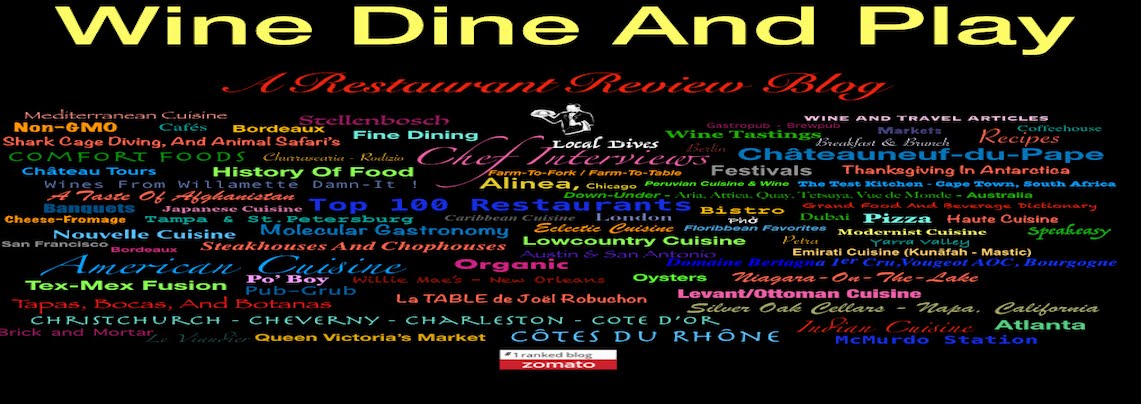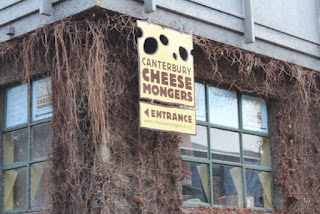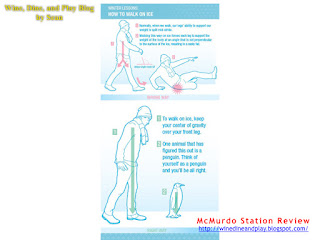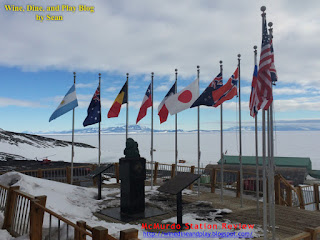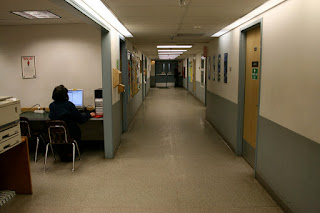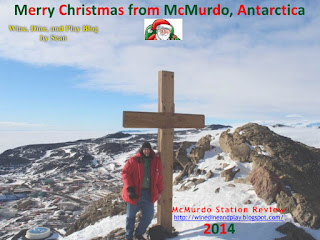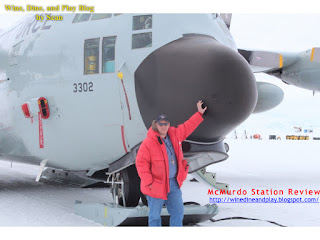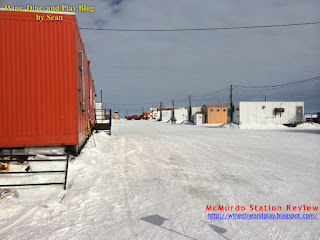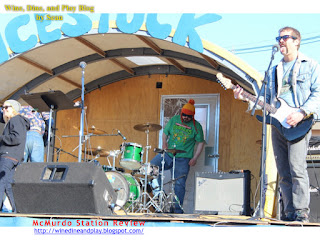A Tour On The Ice
McMurdo Station, Ross Island, Antarctica
Overall Rating: 2/5 stars
August 2014 - March 2015
Article Updated on April 2019
August 2014 - March 2015
Article Updated on April 2019
By Sean Overpeck (CFE)
**A full article and index glossary of restaurants, wines, recipes and travel for
Wine Dine and Play are in the pages section above, or by following these links:
Antarctica, the Earth’s southernmost continent, two times larger than Australia, and about the same size as the United States and parts of southern Canada. Antarctica is also known as the ice continent and is 98% covered in an ice sheet that averages 1.9 km (1.2 mi; 6,200 ft) in thickness. It holds 90% of the world's ice (roughly 70% of the worlds fresh water). It is also the coldest land mass on the Earth where the lowest natural temperature ever recorded was −89.2 °C (−128.6 °F) at the Soviet (now Russian) Vostok Station on 21 July 1983. Though it didn’t always use to be this cold. More than 170 million years ago, Antarctica was part of the supercontinent Gondwana which was a large land mass of the current 7 continents before they broke apart. Antarctica, as we know it today, was formed around 25 million years ago. It used to be farther north, and because of the warmer temperatures, experienced a tropical or temperate climate, was covered in forests and inhabited by various ancient life forms. The name Antarctica is the romanized version of the Greek compound word ἀνταρκτική (antarktiké), feminine of ἀνταρκτικός (antarktikos), meaning "opposite to the Arctic, or the opposite of the North”. It was first sighted in 1820, by the Russian expedition of Fabian Gottlieb von Bellingshausen.
Now that the basic history and science lessons are over, its time to get down to the nitty-gritty of this article, the tour on the ice at McMurdo Station. McMurdo is located on Ross Island, named after explorer James Clark Ross as he passed through what is now known as the Ross Sea and discovered Ross Island (both of which were named after him) in 1841. The island is made up of volcanic rock from the two volcanoes, one of which is still active and is the southernmost active volcano in the world. It is also the starting point of the famous ring of fire. The volcano’s of Mount Erebus and Mount Terror are named after the two ships from James Clark Ross ’s expedition: HMS Erebus and Terror. Terror is also a good way to describe 70% of the people that you are forced to deal with on a daily basis when you work at McMurdo Station. It is hard to explain what the experience of being in Antarctica for a long period of time is like. no matter how I explain it, my friends cannot comprehend all of its majestic beauty and terror. Are you ready for a real taste of McMurdo Station, Antarctica?
McMurdo Station, located at 77 degrees 51 minutes S, 166 degrees 40 minutes E, is the largest Antarctic station. McMurdo is built on the bare volcanic rock of Hut Point Peninsula on Ross Island, the solid ground farthest south that is accessible by ship. The station was established in December 1955. It is the logistics hub of the U.S. Antarctic Program, with a harbor, landing strips on sea ice and shelf ice, and a helicopter pad. Its 85 or so buildings range in size from a small radio shack to large, three-story structures. Repair facilities, dormitories, administrative buildings, a firehouse, power plant, water distillation plant, wharf, stores, clubs, warehouses, and the first class Crary Lab are linked by above-ground water, sewer, telephone, and power lines.
Research is performed at and near McMurdo in aeronomy and astrophysics, biology and medicine, geology and geophysics, glaciology and glacial geology, and ocean and climate systems. Participants of the Antarctic Artists and Writers Program also work at sites near McMurdo Station.
How I rate the McMurdo Experience:
96 - 100
|
is Extraordinary
|
90 - 95
|
is Outstanding
|
80 -89
|
is Above the Average
|
70 - 79
|
is Below the Average
|
60 - 69
|
poor / appalling / “Cac”
|
High points for the scenery, the animals, science, and awe of the frozen continent. Low points for the population and political correctness --- except for the fellow cooks, Chef's, and those who truly supported us -- score a perfect 100 points...
Mcmurdo Station is one of 65 separate research stations in Antarctica, operated by over 30 countries, with its closest neighbor Scott Base ran by the New Zealand (Kiwi) team only two miles away.
(Here is a list of all the stations)
McMurdo is a year-round facility with nearly 1,200 people in the summer months and around 200 in the winter season. Being in the southern hemisphere, the spring and summer months are from late September to January and autumn and winter from February to August.
(Here is a list of all the stations)
McMurdo is a year-round facility with nearly 1,200 people in the summer months and around 200 in the winter season. Being in the southern hemisphere, the spring and summer months are from late September to January and autumn and winter from February to August.
The stations' purpose year round is for science, and in the summer months, there are upward of 300-400 scientists residing at McMurdo doing every form of research you can imagine. During my tour in 2014-15 I saw several of these events in action to include the study of the Weddell Seal, South Polar Skua (a scavenger bird), and the Adélie Penguins named after Adélie Land which was discovered in 1840 by the French explorer Jules Dumont d'Urville (1790 – 1842) who named the land and the penguin after his wife, Adèle.
Other research that was very interesting included test runs for future expeditions to Mars and the search for meteor rocks. The remaining people other than the scientists at McMurdo were the support staff. There were plumbers, engineers, waste management, logistical supply personnel, administrative, medical & dental, fire and rescue, and of course my job, food service. I first became interested in working down south while I was over in Afghanistan in 2013. A year later after making the right connections, I was hired on for the summer season of 2014. The “Galley” as it was known from the old navy group that used to run McMurdo, was the hub of all activity on the station. No matter if you were a scientist or a support staff member, there were two places you always went to. The cafeteria to eat, and the bar to drink. I’ll talk more about the bars later.
I met my boss and several other chefs that I would be working within Seattle, Washington in early August of 2014. We enjoyed a nice summer temperature as we had a day to explore the city, visiting the Pike Place Market, one of the largest fresh seafood and farmers markets in the Northwest, where iconic business names like Starbucks got their first start. After enjoying some walking around and lunch at the Pike Brewing Company, it was time to head down to McChord Air Force Base to begin our journey. Unfortunately, I didn’t get to tour the needle while in Seattle so I will have to return one day.
Joint Base Lewis-McChord is an Army and Air Force base south of Seattle and is named in memory of Colonel William C. McChord, Chief, Army Air Corps Training, and Operations Division who was killed in a plane crash in 1937. McChord is home to the 62nd Airlift Wing which continues to play a major role in the Global War on Terror through airlift efforts and the transportation of troops from nearby Fort Lewis and Naval installations. Fort Lewis is home to 2nd Infantry Division, to which I was apart of when assigned to Camp Casey/Hovey, South Korea in 1998.
Our journey would take us from McChord on a C-17 to Hawaii to refuel, then onward to Christchurch, New Zealand. A very long flight, uncomfortable seats, no inflight movies, and a loud humming noise from the engines. It was your typical military flight as I had been on several of them during my time in the army, and while traveling around Afghanistan. The main reason for this full mode of travel was that we would be going to Antarctica in the winter, and this was the first attempt at doing a winter flight to drop supplies and people off or WINFLY as it was known. Some folks that would arrive later in October enjoyed a regular airline flight, which I would have to wait for when the tour ended.
Our stay in Christchurch was to only be a few days, yet because of bad weather, a few of us were extended by more than one week before a window in the storms opened so we could fly in. I didn’t mind, of course, it gave me a chance to get to know the fellow Chefs I would be working with, and to enjoy the cities food scene. Our group went out exploring to see a city rebuilding and trying to Re: Start from tragedy. A series of Earthquakes destroyed the city and its wonderful old buildings and monuments two years earlier. One thing was for sure, the city had a wonderful food scene as we frequented restaurants such as Fiddlesticks, The Brewer’s Arms, Regatta on Avon, and The Pegasus Arms. Two of our favorites was a local pizza place called Base Woodfire Oven, and a cheese store that we were so impressed with, we ordered large amounts from them and arranged to have that cheese sent down weekly on our food deliveries to McMurdo. They were called the Canterbury Cheesemongers.
Near the Christchurch airport was the New Zealand National Science Foundation Antarctic Center which was a combination of administration for the entire Antarctic Science project, and a tourism site with a museum for kids. From here we were issued all of our cold weather equipment and clothing, then finally began our trip south.
We took another C-17 flight which lasts about six hours from Christchurch to the ice. The C-130, a smaller aircraft takes over eight hours, so I was very thankful. We were all dressed in our cold weather gear from the chart you see above. Less than three hours into the flight, we could take tours of the cockpit, to which I took full advantage of, and to my surprise got to spend extra time up there with the pilots when we started talking about Bagram, FOB Shank and other Afghanistan locations that we had all been to. Everyone else got the quick nickel-dime tour. As I looked out the windows since in the cargo portion of the plane there were none, I could see icebergs and sheets, few of them at first then more and more. We were still over 1000 miles from the continent, yet all of this ice was there. It formed into larger chunks that became so big it looked like a large land mass itself. The first thing the pilot said when I mentioned this, was “so much for global warming!!”
I can agree as for my time there, the temperature got above freezing (32°F) four times, and only one of those times in the summer did it reach 41°F, and that lasted for less than an hour. We landed on an ice runway built onto the McMurdo / Ross ice shelf called Pegasus Field, where the major brunt of operations took place. Pegasus field was named after a C-121 Lockheed Constellation named “Pegasus” that crashed there in 1970. During the stay on the ice, tours are offered to see that crashed aircraft. There was also a smaller airfield used mainly during the summer called Williams field where the C-130’s would land using special ski’s. The Ice shelves of Ross and McMurdo were nearly the size of Texas. At the thin portion of the shelf, it was only twenty feet thick. At the deepest point, it was over 500 feet thick.
Once we landed and the cargo door opened, and you had no doubt that you were on the coldest piece of land on the earth. The wind was not blowing, and the light began to disappear. During this time of year, daylight was only around for about two hours. As the months progressed there would be more, and by October there would be 24 hours of it, but during the winter months from late March to early August, it was complete darkness 24 hours a day. I, unfortunately, did not get a chance to see the Southern Lights (Aurora Australis) while I saw there. We were seeing the first light of the new spring season. The temperature was -35°F, the coldest I had ever been. In 1998 when I was stationed in Korea we had cold weather training where we had to sleep outside, and the temperature got to -5°F. At FOB Shank, Afghanistan during the winter of 2011 it got to a low of -11°F, so this was new to me, and only the beginning. Because when a storm hits, then movies like The Day After Tomorrow do not seem so far fetched.
We gathered aboard a large transportation vehicle called "Ivan The Terror Bus", that held about fifty people in it. Whether it was done on purpose or not, there was no heat, and the fourteen mile trip from Pegasus Airfield to McMurdo took over an hour, and I felt like I was going to die from the cold. It never felt so good to get inside a warm building and do the briefings, before going back out in the cold again to get to the living quarters. By that time the weather had turned, the wind was picking up, and the snow was falling. I thought it was cold before, but now it was even colder.
 |
| The picture was taken at the end of summer, so not so cold only 25°Fahrenheit |
Storms came through all the time and several were on you very quickly with little warning. The weather guidelines were simple. If you couldn’t see more than five miles in the distance, then a storm was on its way, and you didn’t want to go far. There were three categories or conditions to the weather. Condition 3 was a nice day with no problems. Condition 2 was a storm with little visibility, strong winds, and heavy snow. Condition 1 was the mega-storm that came a few times during the winter and autumn time periods, and they were bad. Hurricane force winds, heavy snow, blinding conditions, and whiteouts. I saw one Condition 1 storm while I was there and more Condition 2 storms than I can count. During these #1 storms, ropes were connected to the buildings for you to hold on to because you could not see. Condition 1 storms required you to stay indoors, so only in an emergency would you go outside, to begin with. If you lost that rope, then you could die out there. It wasn’t uncommon to see a sixty-pound piece of wood get picked up and shot like an arrow into another building like a tornado would do as it passed through a town in Nebraska. Below is a video I took of walking to work in a category condition 2 storm:
See the Storm video here:
McMurdo Station is made up of several buildings and structures, unlike our neighbor Scott Base which is one continuous unit, connected together so that you don’t have to worry about going outside. You had about twelve separate buildings that were living quarters. The older buildings were three stories, and two rooms shared a bathroom and shower unit. Unless you were the President, you had to share a room. Some buildings were designed to have four or more people in one room, such as the main hub known as the big blue building or building 155 where the cafeteria or “galley” as it was called and located.
- Building 155; galley, radio station, general store, recreation centers, offices, billets
- Albert P. Crary science center
- The Chapel of the Snows
- The Dorms
- The Chalet
- Gym
- Various Science Buildings
- The Coffee House
- The McMurdo Bar
- Southern Bar
- Firehouse
- Medical
- Food Storage Warehouses
- Mechanical-Garage
- Waste Management
My room was in one of the newer buildings where you still shared the room with one other person, however, there were no shared bathrooms. The bathroom and showers were down the hall. It reminded me of Afghanistan. Each billet had a lounge where there was a pool table, and large flat screen tv to watch movies, two wires to connect to the slowest internet known to man, and a telephone that you could use to call the United States, via a prepaid calling card. There was also a large selection of VHS movies to watch and books to read.
Each building’s lounge and every building for that matter had over 10 waste bins designated for different forms of recycling. They recycled everything here, and when the cargo ship arrives to drop off supplies at the end of the summer, all the recyclables and trash are put aboard and sent sailing back to a landfill in California. Whether the products continue down the recycle path once they reach the West Coast, who knows?? Keeping the buildings clean was everyone's job as we were all assigned duties on a weekly cleaning roster. Even in the Galley Kitchen, we had the same bins, only we had a few more bins for different items. The recycling and the removal of all trash from the continent was one of many things that the Antarctic Treaty covered. The treaty is signed by 53 separate nations as of 2015 and covers 14 separate articles on what can and cannot be done when you come to Antarctica. These articles are as follows:
• Article 1 – The area is to be used for peaceful purposes only; military activity, such as weapons testing, is prohibited but military personnel and equipment may be used for scientific research or any other peaceful purpose;
• Article 2 – Freedom of scientific investigations and cooperation shall continue;
• Article 3 – Free exchange of information and personnel in cooperation with the United Nations and other international agencies;
• Article 4 – The treaty does not recognize, dispute, nor establish territorial sovereignty claims; no new claims shall be asserted while the treaty is in force;
• Article 5 – The treaty prohibits nuclear explosions or disposal of radioactive wastes;
• Article 6 – Includes under the treaty all land and ice shelves but not the surrounding waters south of 60 degrees 00 minutes south;
• Article 7 – Treaty-state observers have free access, including aerial observation, to any area and may inspect all stations, installations, and equipment; advance notice of all activities and of the introduction of military personnel must be given;
• Article 8 – Allows for good jurisdiction over observers and scientists by their own states;
• Article 9 – Frequent consultative meetings take place among member nations;
• Article 10 – All treaty states will discourage activities by any country in Antarctica that are contrary to the treaty;
• Article 11 – All disputes to be settled peacefully by the parties concerned or, ultimately, by the International Court of Justice;
• Articles 12, 13, 14 – Deal with upholding, interpreting, and amending the treaty among involved nations.
The main objective of the ATS is to ensure in the interests of all humankind that Antarctica shall continue forever to be used exclusively for peaceful purposes and shall not become the scene or object of international discord. Pursuant to Article 1, the treaty forbids any measures of a military nature, but not the presence of military personnel or equipment for the purposes of scientific research.
Other Agreements include the protection of Seals, Fauna, and in 1982, a special agreement that denied the use of mineral resourcing such as gold, copper, or any other natural resource. China is in the process of building a fifth research base on the continent and they will be the first country to not sign a new treaty obligation when the current treaty ends in 2040. Several years ago, oil was discovered on Antarctica, more than the current world supply times ten. China will not be the only country, and once that treaty does end, mineral resourcing will begin.
Other Buildings:
Other buildings on McMurdo included the Chapel of the Snows for all religious services, as well as counseling. From the inside, there was also a wonderful view of the Transantarctic Mountain Range to the South. Also, there has been one marriage that has taken place at the chapel between Anthony and Christine Powell, and the documentary movie Antarctica: A Year On Ice covers that wedding.
Besides the chapel and communication buildings, there was the Chalet, where VIP’s would visit, they would be entertained. Outside the Chalet on the patio facing the South is a bust of United States Navy Rear Admiral Richard Evelyn Byrd and a series of flags.
For science, there was a state of the art building called the Albert P. Crary Science and Engineering Center dedicated in honor of geophysicist and glaciologist Albert P. Crary (1911-1987), the first person to set foot on both the North and South Poles. The Crary Lab has five pods built in three phases to make 4,320 square meters of working area. Phase 1 has a two-story core pod and a biology pod. Phase II has earth sciences and atmospheric sciences pods. Phase III has an aquarium. Two times per week, scientists would offer tours of all five pod sections as seen below in the diagram. This tour was very informative, and you got to know some of the things that your tax dollars were funding, and why.
The Coffee House and the two bars are known as the southernmost bars in the world, where one is open year round and the other bar is open only during the summer months. It becomes like a typically loud, and smelly nightclub on the weekends, whereas the Coffee House and the second bar are a very quiet and relaxed place to drink. The Coffee House offers wine and coffee, and you can play board games, or go onto the internet. I would spend more time at the Coffee House then the bars, as I was not into that scene since being in the Army twenty years before.
The Gym was small but had everything you needed from elliptical and treadmill machines, dumbbells, gym mats, and a few weight-lift machines. The worst part about the gym was the smell, as it was notorious on McMurdo that one gay lady that worked out daily, also did not believe in wearing underarm deodorant, and you could always smell her as she walked by. Even in the dining room, her odor was present and disgusting. If you tried to say something to her, she would report you under a harassment clause regarding homosexuality and bigotry - I shit you not folks. When she worked out, it became like a weapon of mass destruction in the gym. You could not work out or even be in that building while she was their or up to thirty minutes after she left unless you completely aired the place out. Thank god she was a winter-over and left two months into my tour so that I could go back to the gym and exercise. Another disappointment to the gym was the cold weather outside. Inside it was nice and warm, and you built up a sweat from your workout. You couldn’t walk back outside unless you dressed back up in the warm gear, which meant the sweat and body odor got inside all your gear, and you would have to wear it every time you went outside that day. Coming up with other ways to stay warm as you left the building to go back to your own building became interesting, but it was managed. As the temperature increased in the summer, and we were climatized to the cold weather, walking back and forth in shorts and t-shirts with the temperature being 25°F was easy.
Last but not least was building 155. When you look at pictures of McMurdo you will see a large blue building in the center of town. This was the largest building where a few ATM machines were located, offices, the store where you could make all your souvenir and alcohol purchases, DVD rentals, the Antarctica radio station, billets on the second floor, and the Galley.
The dining room had about 50 tables to accommodate around 300 at maximum capacity. The main serving area had a large grill for short order cooking of hamburgers, hot dogs, and assorted specials. Next to this area were the main serving lines, vegetarian line, action cooking stations, dessert line, sandwich bar, and the highlight that everyone on the base loved, the homemade pizza line, wherein the season over 20,000 large pizzas are prepared and consumed. This is a funny fact considering that a large group of people would constantly complain that there was never enough healthy food, yet the unhealthiest item was the most consumed. Hypocrites as you will read more about them.
The kitchen was a combination of old and new. We had steam jacket kettles with steam vents still attached from when the Navy ran this kitchen in the 1950s, and modern kitchen equipment that included pressure tilt skillets and combitherm ovens. Three meals were offered per day to feed 1,200 per meal with a crew that prepared some top notch meals and a bakery that rivaled the pastry shops back home. On the backside of the galley was a loading dock where food was delivered weekly from the storage warehouses, ordered and based on what we needed for the menu the following week. Deliveries were two times per week. The main load from the warehouses, and the Freshies order from the C-130’s that had just flown in from New Zealand. The Freshies were the biggest treat for everyone when they came. Without that delivery, there were no salads, fresh vegetables, or fruits to consume. The offloading process was nearly an all-day affair. When moving boxes in and out we took frozen goods into the freezer, which during the winter months was a way for us to warm up as the freezer was -20°F, while outside on the dock with the elements it was -50°F on the bad days.
 |
| My Boss at the Carving Station / Serving Line |
 |
| The Kitchen Chef's |
Throughout the season the chefs and all those that worked in the cafeteria worked non-stop to produce the best quality meals they could be based on what we had to cook, and the equipment that we had to cook it in when it actually worked and didn’t break down. Through this and the wonderful holiday, meals prepared, in my twenty years of food service I had never worked in a place where the community and customers were the most ungrateful group of people I ever met. As I mentioned earlier when I said that terror was a good way to describe the McMurdo population and hypocrites. I would always walk around and chat with the customer asking them how their meal and day was, what we could do to improve and so forth. I had been doing this for every assignment I had over the years, and it was a great way to meet people, and get a feel for what they liked and disliked. They would say one thing to me, then complain about fifty other things to others. After some time, I stopped talking with them and stopped walking the dining room, because nothing they said was positive to pass to my crew that worked so hard to make the population happy. They also would claim that galley management didn’t listen or care about their needs. Give me a break!
The Thanksgiving Meal was the only meal of the year where praise was received, and a standing ovation was given to all the chefs in the kitchen. The following day it was back to the contempt and hatred, blaming their bad days on the food we prepared. Funny story...We had people requesting the pizza on Thanksgiving, one of two meals that season that we shut the pizza line down. God help me!
To read about that wonderful Thanksgiving meal, follow this link:
The Christmas meal was also very memorable, and the chefs did yet another wonderful job. There was also a Christmas Party held at the motor pool where there were bands, and carols being sung. It was a nice ending to the year.
You know its bad when you have to hold a food forum and explain to the people that food is only delivered once per year, the equipment that we have can only do so much, and the budget limits have to be met. After all, we were in Antarctica if they didn’t know that already. Yet even after that, they expected The Four Seasons or The French Laundry. I had never seen so much negativity from a group of people before in my life. Most were angry at life itself. When a group of Senators and Congressman arrived to take a tour, they protested them and made horrific signs of hatred and other unspeakable things. These were politicians that funded the project, or in other words, signed for there damn paychecks. When the late Senator John McCain arrived in 2006 before he ran against Obama, I heard that some of the people nearly started a riot wanting to protest him. A large group of the population lives in the Washington and Oregon region, plus the Scientists were all from Liberal Art campuses. Though I’m Libertarian and don’t like the Republican or Democrat Party, you knew where most of the population stood when it came to politics, very left to nearly Socialist. They were spoiled, used to entitlement, and having things there way. When I showed favor to my fellow chefs and not the population, that puts the target on my back.
When you work at a harsh location where you can’t get supplies on a regular basis like Afghanistan, Iraq, or here in Antarctica, then you have to give up certain creature comforts that you normally take for granted in the real world. Most of the population did not know how to do that. Why they were even here, I had no clue. How they managed to survive without their free-range chicken, double mocha latte’s, and GMO-free grains baffles me to this day. By the time I left after eight months I was thankful for the beauty, I saw in this continent but was very thankful that I would hopefully never see people from this population again as long as I lived. The chefs were fantastic, but 70% of the others were horrible, sad, and angry people.
 |
| Pizza Station |
 |
| Dress up Day for the Pizza Man |
 |
| Hand Wash sinks that a lot of people didn't use |
I’m working in Iraq now and one of the same company’s that worked in Antarctica with us also works over here. That company with three letters to the title that shall not be named has the same problems over here, though not as many whiny people.ether they are Americans or foreign nationals, a large portion of them do not wash their hands, and when people get sick over here, the medical staff blames the department heads of that company because they know. There is no assigned blame to the kitchen staff. One change from Iraq to Antarctica is that the company folks here are nicer than the ones in Antarctica, so it's not the company, but just the quality of the people they hire to do the work. Here that company’s workers that are American, though some do not wash their hands, are from the mid-west, south, and southwest, not Oregon, Washington, and other Liberalville places. Call me harsh, call me an asshole, but the truth is the truth.
 |
| The Galley Crew |
 |
| Halloween Party |
The police call is another perfect example. Two or three times during the season the camp did a “keep Antarctica clean” initiative. Everyone had to do a police call. You were assigned a specific area, based on where you worked and picked up all the trash. Well, the bias went to other groups as some never even participated. The galley crew was in charge of cleaning around building 155, the bars, coffee, house, and gym. These areas were the heaviest trafficked areas on the base. So when people did their police call around their work areas they were done in ten minutes. Hours later when we were done, picking up everyone else's trash, cigarette butts, beer cans, and other things that you don’t even want to mention, we had ten or more full bags of trash. This is an example of the people there. Again not all the people, but a lot were. Complainers, wanting to be spoon fed, have everything there way, but when it came to doing it themselves, they did not participate. Blame others, and feel like your better than everyone else. The typical mentality to a self-entitled person, or as I like to refer to them as “leeches” sucking off the good of others, or just plain assholes.
We got one day off per week and during those times with the activities of hiking and trips it made the tour to Antarctica a great experience. There were a few of the activities you could take advantage of:
- Arrival Heights Hike
- Scott’s Discovery Hut
- Hut Point Hike
- Scott Base Visit
- Observation Hill Hike and Climb
- Cape Evans
- Williams Field
- NASA Long Duration Balloon Tour
- Pegasus Crash Sight
- Pressure Ridge Tour
- Observation Tube
- Trips to the Dry Valley
- South Pole Visit
- Crary Lab Tours
The Hut Point hike is the first thing I did when I had free time after the arrival and would do the hike several times per week after work to see the wildlife. It was a one-mile hike from the station, and everyone took advantage of the hike. Once you make your way there, you pass by Scott’s Discovery Hut built in 1902 during his first visit. The point is beyond the hut up a small hill where a cross dedicated to a man named Vince is located. The views of the Transantarctic Mountain Range are spectacular from the top of the point. From this point, you can continue your hike up to Arrival Heights or go back to the station. This is also a good location to see penguins, Weddell Seals, and when the ice melts away and the ocean is in full view, you can spot whales.
Penguins, Seals, and Whales:
 |
| Weddell Seal with her Pup |
 |
| Weddell Seal in December getting some air |
 |
| Seals and Adélie Penguins |
 |
| Adélie Penguin Colony...Follow the leader |
 |
| Adélie Penguin just jumped out of the water |
Video of the Adélie jumping out of the water onto land:
 |
| Adélie trotting about |
 |
| Adélie looking at the lens |
 |
| Minke Whales near Hut Point in February (end of summer) |
Weddell Seal's Scientific Research Advert:
Scott’s Discovery Hut opened in the late summer for tours where the New Zealand Antarctic Heritage Trust had spent time and great effort to restore everything back to the way it was in 1902. Robert Falcon Scott (June 6, 1868 - March 29, 1912) ended his first expedition in 1904 but returned in 1910. He was racing Roald Amundsen to be the first man to the South Pole. They reached Ross Island on January 4, 1911, and prepared for a sled trip to the South Pole. Amundsen reached the South Pole on January 4, 1912, and Scott's team reached the pole on January 18, 1912. Scott was sorely disappointed to find Amundsen's Norwegian flag placed there before him. In his journal, he wrote, "Great God! This is an awful place, and terrible enough for us to have labored to it without the reward of priority.” Scott died during a blizzard on the return trip. The South Pole Station is named Amundsen-Scott Station in memory to both explorers.
The Arrival Heights Hike continues past the Hut Point and back around a large hill all the way to the top near to where NASA has set up several telescopes. There is also a Mary Statue halfway up the hill dedicated to Seabee that died in this area back in the 1950s. It is a good ninety-minute walk, but the views are even better than the ones at the point. The heights are a specially protected area, and only small areas are allowed to be hiked up to, the rest is off limits with very stiff fines, and expulsion from the continent.
 |
| Nasa Weather Station, Mary Statue on the hill below |
 |
| Arrival Heights with Erebus in the background |
 |
| The Ross Sea, view from Arrival Heights |
Observation Hill was 788 feet high and when in good shape about a twenty-minute hike to the top. This why my fellow Chef’s and I took nearly an hour to get to the top. Once there the views of Mount Erebus and Mount Terror are spectacular. There is also a clear view of the Ross Ice Shelf from the top. I went to the top three times during my tour, and every time was as great as the first. At the top is a large nine-foot tall cross called the Terra Nova Cross, named after the expedition where Scott died.
 |
| On Top of OB Hill |
Williams Field is located on the edge of the McMurdo Ice Shelf and is where the smaller C-130 cargo planes land on ice ski’s to deliver supplies. There was a small cafeteria set up to feed the nearly 100 people that worked there and at Pegasus Field. One visit we had we were granted a tour of an aircraft and its workings by the Air Force.
LDB, which stands for the Long Duration Balloon Facility operated by NASA is located further onto the Ice shelf and good one hour drive when the weather is good. We had a small cafeteria out there as well to feed the scientists and support staff of around 70. This facility was the only one of the three where there were constant accolades and praise for the food prepared. It’s a shame these folks only ate breakfast at building 155 instead of lunch and dinner. It would have made things better for the other Chef’s. The chefs would volunteer to work at LDB and I wouldn’t blame them, as I wanted to as well. The LDB sight also houses the tallest building in Antarctica which was around four stories.
The LDB sight launched large balloons into the lower atmosphere with equipment attached to measure conditions of the earth at that height. The LDB sight had five scientific hangers for their equipment and it was an interesting sight to see.
The Observation Tube was open for one month and was placed on the ice frozen above the ocean. A hole was drilled down the ice and the tube was put inside. You could climb down the tube about fifteen feet into a small room surrounded by thick glass and see the world of Antarctica below the sea. A fantastic sight, and sounds of the Seals in their natural environment. The tube is a tight fit, so when your over six feet tall like me, it can be hard to get out of it. It took nearly fifteen minutes for me to find the footing where my knees weren’t hitting the tube wall to climb back up. One person a few days before who was much heavier in the weight needed to have the fire department come and pull them up.
Cape Evans was a special trip that took three hours driving on the ice with the ocean below us and was done early in the season before the ice began to melt. Once the ice melts there is no way to get to Cape Evans. We went in large groups of twenty and once at the Cape, saw another hut built by Scott’s Team in 1910 for further exploring. This is where I saw my first glacier of ice and even more beautiful views of Mount Erebus. The hut was larger than the discovery hut, and much more impressive. Inside there was a lot more supplies that put their trip in greater focus to us, as well as a sad scene of a dog’s skeletal remains still attached to a chain, left at the hut to die when the humans evacuated before the winter months.
The Pegasus Crash Site was past the airfield where we landed, and on October 8, 1970, a C-121 Lockheed Constellation named “Pegasus” crashed while attempting to land in near-zero visibility conditions. Pegasus Field was subsequently named in the aircraft’s honor. Most of it is buried below the snow and ice, but you can still walk along the top of it and on the wings.
The Pressure Ridge was located nearer to Scott Base on the ocean ice where the pressure from two currents pushed the ice shelf up into ridges and formed fantastic ice sculptures. Once on the tour, you could walk around and see nature at its finest, as the following year it may all melt away and start again. In 2014, the ridge had been in place for three years without melting, so as the years go by, it will get bigger and better.
When we weren’t working and not out hiking and exploring, or getting fellow co-workers out of trouble at the bars, then it was a good time to relax and play trivia at the Coffee House, take Aikido martial art classes, or just watch some movies. The Lounge areas had the large TV’s, with old VHS videos to watch, but of course, we had newer movies on thumb drives. All we needed was an HDMI cord. It was fun to watch movies about Antarctica. Before coming here, we would watch these films and think about how great it would be to come here and see the different sights, only to realize that the films were way off. Famous films about Antarctica include Alien vs Predator, the apocalyptic film The Day After Tomorrow, which showed one scene of an ice shelf collapse from global warming (yeah right!!!). Eight Below is based on the true story of dogs that were left in Antarctica over the winter, The Thing (1982 and 2011 versions) and The X-Files movie. The funny thing is that not a single film about Antarctica is actually filmed in Antarctica. So all those wonderful sights that you see in the movies are filmed somewhere else, usually in Canada.
Now when it comes to documentaries, all of them are filled in Antarctica, the most famous being March of the Penguins, and Antarctica: A Year On Ice. The heavy metal band Metallica also did a live concert album called Freeze ‘Em All at the Carlini Argentine Base on King George Island in December 2013, becoming the first band to perform on all seven continents. The YouTube video of their concert is below.
Metallica Concert on the Ice Video:
On New Year's Eve, the Chef’s and a few others got together and drank some Single Malt Scotch named after Shakelton, a remake of some scotch found under his hut when restorations were being made. A new Zealand whiskey Company traced the origins of the scotch and recreated it, and repackaged it for sale. I love single malt scotch, and this was pretty harsh stuff. The Mackinlay's Rare Old Highland Malts are re-creations of the original malt whiskey shipped to Antarctica in 1907. We drank the scotch with some ice that some scientists had brought us from a glacier closer to the South Pole that had been frozen for over 20,000 years. It was the purest water I had ever drunk before and went great with the scotch as well. This was the most interesting yet memorable New Years I had ever had before.
Color - Light honey, straw gold with shimmering highlights.
Nose - Soft, elegant & refined. Delicate aromas of crushed apple, pear and fresh pineapple arouse the senses. The spirit is exciting and vibrant with attractive notes of oak shavings that release hints of buttery vanilla, creamy caramel, and nutmeg. A whisper of marmalade, cinnamon and even a tease of smoke, ginger and muscovado sugar complete this spectrum of delight.
Taste - With a generous strength of 47.3% this gives the spirit plenty of impact on the palate but in a mild warming manner. Harmonious and exhilarating. Whispers of gentle bonfire smoke slowly give way to spicy rich toffee, treacle and pecan nuts. These enticing flavors linger lovingly on the palate but are soon combined by a sensual, complex array of creme brûlée, orange rind, and freshly baked bread. It is a remarkable tapestry of tantalizing taste sensations which truly rewards the palate.
After the New Year, there was a tradition that goes back to the roots of the Liberal Hippy Woodstock of 1969 only here it was called Icestock. The population got together, we barbecued, there was a chili cook-off, and a bunch of bands played. Some music was good, but others were a loud noise. I stayed for a few hours, mainly around the grill with fellow Chef’s so I could look like I was enjoying the festival before making an early exit to go watch a movie. One of our cooks was in a band playing drums so mainly I hung around to see him play and show my support.
The Kitchen and Galley crew did enjoy some other down times and we had movie nights like the “Big Lebowski” movie night where we dressed up and drank White Russians like “The Dude” did. We also had to get-togethers and a small party dedicated just to us, where the beer was given to us for free, and we made some great food that only we ate. So again being around the crew was wonderful and a made some good friends like James, Andrew, and Justin to name a few.
I would not want to go back because of the population but would do a cruise their to see the peninsula side from South America. My only main regret was that I did not get a chance to visit the South Pole to just say that I saw it, and have a picture taken at the marker. My boss went down for a few days and he didn’t want to. I volunteered, but he had to go. You never know what the future may hold, and if tourism is offered to the South Pole Station one day then I’d love to go. For now, I am in no rush.
After the new year, the ice still had not yet melted from the constant 24-hour summer heat, so the Polar Star was sent in. In February the main vessel for supplies for the coming year would be arriving, and the past years the ice on the ocean melted away on its own, but this year it was still ten feet thick. The Polar Star is the United States Coast Guard Cutter Ice Breaker. When it arrived in the McMurdo Sound it went back and forth for nearly a week breaking up the ice. Once they docked at the Ice Dock, which as it sounds, is a pier and loading or offloading dock made from the ice shelf. We gave the crew a bunch of pizza’s, and in return, they gave us a VIP tour of the entire ship to include their galley and operations. It was a wonderful privilege that few people enjoyed.
 |
| Two Galley Crews |
 |
| At the Stern |
Video of the Polar Star Breaking the Ice:
During this time several ships would dock, mainly research and cargo ships. From time to time cruise ships and civilian tours will dock, but that year the ice was so bad that the tours were canceled.
A lot happened in those eight months, but there was no place like home. After completing the tour, it was time to go home. The first attempt led to a boomerang where the flight turned around because the C-17 couldn’t land as the weather turned bad. That same day I saw my first Emperor Penguin up close as the poor guy was malting and not a happy camper. Normally from what I was told you would see as many Emperor’s as you would the Adélie’s, but that year the Emperor’s have been scarce.
When we finally got off the ice, one day was spend back in Christchurch, and once we stepped off the plane our noses exploded. Antarctica has no natural smells, so when we arrived back in New Zealand, we could smell the trees, grass, everything, and it was like a sensory overload. It was also 68°F and I thought I would die from heat exhaustion since it was 25°F when we left the ice that day. I then headed over on a five-day layover tour in Australia before flying home. While in Melbourne on my first stop I enjoyed wine tastings in the Yarra Valley with vineyards such as Yarra Yering and Coldstream Hills Vineyard. Later with wonderful lunches and dinners at Vu de Monde and Attica before going onto Sydney to see the Opera House, and touring the Blue Mountains. Also while enjoying the city, I dined at Tetsuya’s and Quay. All four of these restaurants from Melbourne to Sydney were in the top 100 restaurants of the world, and are all reviewed here on The Wine, Dine, and Play Blog.
 |
| Emperor Checking me out |
 |
| Waiting for the Plane |
 |
| A colony of Emperors taken on Ross Island |
I flew back home to see my brother in Ohio for a few days in freezing weather again as it was still winter and early spring in the states, then enjoyed some time with my fiancé before traveling to my next assignment in Iraq. So from 25°F the day I left Antarctica to 68-80°F in New Zealand and Australia, back to 20°F in Ohio, to the 90s in Puerto Rico, and an arrival in Baghdad where the temperature was cool to the locals at 105°F. That summer, the high temperature would hit 153°F. One year earlier I had landed on the Ice and it was -45°F. That is my world record for sure.
McMurdo Station
PSC 769 Box 800
APO AP 96599-1035
Ross Island, Antarctica
GPS Coordinates:
-77.841878 Latitude
166.686345 Longitude
Information:
Website:
| |
Social Media & Accolades:
| |
“Culinary perfection consists not in doing extraordinary things,
But in doing ordinary things extraordinarily well.”
-Angelique Arnauld (1591-1661)
Who is John Galt?
TTFN
